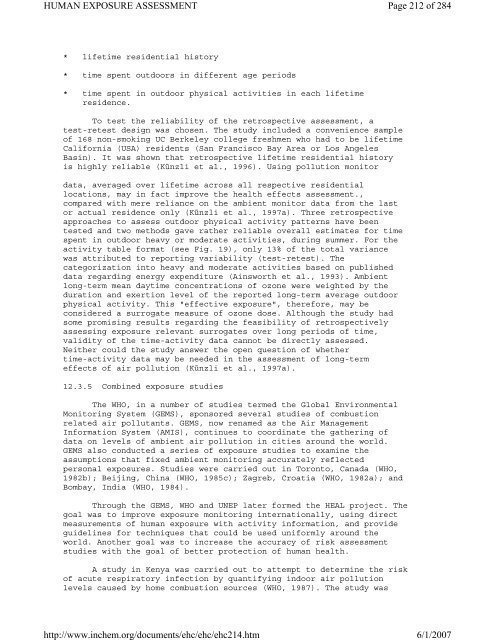Environmental Health Criteria 214
Environmental Health Criteria 214
Environmental Health Criteria 214
You also want an ePaper? Increase the reach of your titles
YUMPU automatically turns print PDFs into web optimized ePapers that Google loves.
HUMAN EXPOSURE ASSESSMENT<br />
* lifetime residential history<br />
* time spent outdoors in different age periods<br />
* time spent in outdoor physical activities in each lifetime<br />
residence.<br />
To test the reliability of the retrospective assessment, a<br />
test-retest design was chosen. The study included a convenience sample<br />
of 168 non-smoking UC Berkeley college freshmen who had to be lifetime<br />
California (USA) residents (San Francisco Bay Area or Los Angeles<br />
Basin). It was shown that retrospective lifetime residential history<br />
is highly reliable (Künzli et al., 1996). Using pollution monitor<br />
data, averaged over lifetime across all respective residential<br />
locations, may in fact improve the health effects assessment.,<br />
compared with mere reliance on the ambient monitor data from the last<br />
or actual residence only (Künzli et al., 1997a). Three retrospective<br />
approaches to assess outdoor physical activity patterns have been<br />
tested and two methods gave rather reliable overall estimates for time<br />
spent in outdoor heavy or moderate activities, during summer. For the<br />
activity table format (see Fig. 19), only 13% of the total variance<br />
was attributed to reporting variability (test-retest). The<br />
categorization into heavy and moderate activities based on published<br />
data regarding energy expenditure (Ainsworth et al., 1993). Ambient<br />
long-term mean daytime concentrations of ozone were weighted by the<br />
duration and exertion level of the reported long-term average outdoor<br />
physical activity. This "effective exposure", therefore, may be<br />
considered a surrogate measure of ozone dose. Although the study had<br />
some promising results regarding the feasibility of retrospectively<br />
assessing exposure relevant surrogates over long periods of time,<br />
validity of the time-activity data cannot be directly assessed.<br />
Neither could the study answer the open question of whether<br />
time-activity data may be needed in the assessment of long-term<br />
effects of air pollution (Künzli et al., 1997a).<br />
12.3.5 Combined exposure studies<br />
The WHO, in a number of studies termed the Global <strong>Environmental</strong><br />
Monitoring System (GEMS), sponsored several studies of combustion<br />
related air pollutants. GEMS, now renamed as the Air Management<br />
Information System (AMIS), continues to coordinate the gathering of<br />
data on levels of ambient air pollution in cities around the world.<br />
GEMS also conducted a series of exposure studies to examine the<br />
assumptions that fixed ambient monitoring accurately reflected<br />
personal exposures. Studies were carried out in Toronto, Canada (WHO,<br />
1982b); Beijing, China (WHO, 1985c); Zagreb, Croatia (WHO, 1982a); and<br />
Bombay, India (WHO, 1984).<br />
Through the GEMS, WHO and UNEP later formed the HEAL project. The<br />
goal was to improve exposure monitoring internationally, using direct<br />
measurements of human exposure with activity information, and provide<br />
guidelines for techniques that could be used uniformly around the<br />
world. Another goal was to increase the accuracy of risk assessment<br />
studies with the goal of better protection of human health.<br />
A study in Kenya was carried out to attempt to determine the risk<br />
of acute respiratory infection by quantifying indoor air pollution<br />
levels caused by home combustion sources (WHO, 1987). The study was<br />
http://www.inchem.org/documents/ehc/ehc/ehc<strong>214</strong>.htm<br />
Page 212 of 284<br />
6/1/2007

















